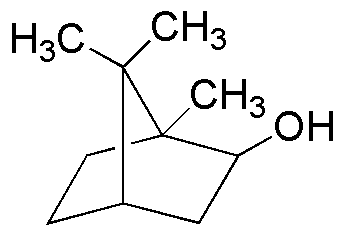Isoborneol is widely utilized in research focused on:
- Fragrance and Flavor Industry: It is a key ingredient in perfumes and flavorings due to its pleasant odor, often used as a natural alternative to synthetic compounds.
- Pharmaceuticals: Isoborneol serves as a precursor in the synthesis of various medicinal compounds, enhancing the efficacy of certain drugs.
- Natural Insect Repellents: Its properties make it effective in formulating eco-friendly insect repellents, appealing to consumers seeking sustainable solutions.
- Cosmetic Products: Used in skin care formulations for its soothing properties, isoborneol helps improve product texture and stability.
- Research Applications: In organic chemistry, it is employed as a chiral building block, facilitating the development of complex molecules in academic and industrial research.
General Information
Properties
Safety and Regulations
Applications
Isoborneol is widely utilized in research focused on:
- Fragrance and Flavor Industry: It is a key ingredient in perfumes and flavorings due to its pleasant odor, often used as a natural alternative to synthetic compounds.
- Pharmaceuticals: Isoborneol serves as a precursor in the synthesis of various medicinal compounds, enhancing the efficacy of certain drugs.
- Natural Insect Repellents: Its properties make it effective in formulating eco-friendly insect repellents, appealing to consumers seeking sustainable solutions.
- Cosmetic Products: Used in skin care formulations for its soothing properties, isoborneol helps improve product texture and stability.
- Research Applications: In organic chemistry, it is employed as a chiral building block, facilitating the development of complex molecules in academic and industrial research.
Documents
Safety Data Sheets (SDS)
The SDS provides comprehensive safety information on handling, storage, and disposal of the product.
Product Specification (PS)
The PS provides a comprehensive breakdown of the product’s properties, including chemical composition, physical state, purity, and storage requirements. It also details acceptable quality ranges and the product's intended applications.
Certificates of Analysis (COA)
Search for Certificates of Analysis (COA) by entering the products Lot Number. Lot and Batch Numbers can be found on a product’s label following the words ‘Lot’ or ‘Batch’.
*Catalog Number
*Lot Number
Certificates Of Origin (COO)
This COO confirms the country where the product was manufactured, and also details the materials and components used in it and whether it is derived from natural, synthetic, or other specific sources. This certificate may be required for customs, trade, and regulatory compliance.
*Catalog Number
*Lot Number
Safety Data Sheets (SDS)
The SDS provides comprehensive safety information on handling, storage, and disposal of the product.
DownloadProduct Specification (PS)
The PS provides a comprehensive breakdown of the product’s properties, including chemical composition, physical state, purity, and storage requirements. It also details acceptable quality ranges and the product's intended applications.
DownloadCertificates of Analysis (COA)
Search for Certificates of Analysis (COA) by entering the products Lot Number. Lot and Batch Numbers can be found on a product’s label following the words ‘Lot’ or ‘Batch’.
*Catalog Number
*Lot Number
Certificates Of Origin (COO)
This COO confirms the country where the product was manufactured, and also details the materials and components used in it and whether it is derived from natural, synthetic, or other specific sources. This certificate may be required for customs, trade, and regulatory compliance.


